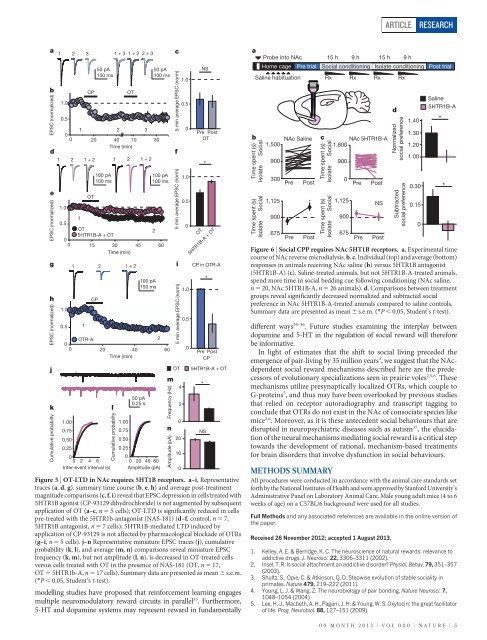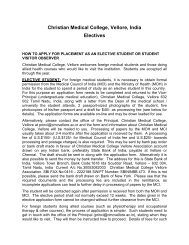Feature Article - Nature Magazine
Feature Article - Nature Magazine
Feature Article - Nature Magazine
You also want an ePaper? Increase the reach of your titles
YUMPU automatically turns print PDFs into web optimized ePapers that Google loves.
ARTICLE<br />
RESEARCH<br />
a<br />
b<br />
EPSC (normalized)<br />
d<br />
e<br />
EPSC (normalized)<br />
g<br />
h<br />
EPSC (normalized)<br />
j<br />
k<br />
Cumulative probabilty<br />
1 2 3 1 + 3 1 + 2 2 + 3<br />
1<br />
1.0<br />
0.5<br />
1.0<br />
0.5<br />
1 2<br />
3<br />
0<br />
0 20 40 10 30<br />
Time (min)<br />
0<br />
0<br />
1.0<br />
0.5<br />
2<br />
1<br />
1<br />
1 + 2<br />
OT<br />
15<br />
50 pA<br />
100 ms<br />
CP OT<br />
100 pA<br />
100 ms<br />
OT<br />
5HTR1B-A + OT<br />
1<br />
CP<br />
2<br />
1<br />
2<br />
30 45<br />
Time (min)<br />
1 + 2<br />
1 + 2<br />
50 pA<br />
100 ms<br />
100 pA<br />
100 ms<br />
modelling studies have proposed that reinforcement learning engages<br />
multiple neuromodulatory reward circuits in parallel 33 . Furthermore,<br />
5-HT and dopamine systems may represent reward in fundamentally<br />
2<br />
100 pA<br />
150 ms<br />
60<br />
OTR-A<br />
2<br />
0<br />
0 20<br />
40<br />
60<br />
Time (min)<br />
1.00<br />
0.75<br />
0.50<br />
0.25<br />
0<br />
0 2 4 6<br />
Inter-event interval (s)<br />
l<br />
Cumulative probabilty<br />
1.00<br />
0.75<br />
0.50<br />
0.25<br />
50 pA<br />
0.25 s<br />
0<br />
0 20 40 60<br />
Amplitude (pA)<br />
m<br />
Frequency (Hz)<br />
n<br />
Amplitude (pA)<br />
c<br />
5 min average EPSC (norm)<br />
f<br />
5 min average EPSC (norm)<br />
i<br />
5 min average EPSC (norm)<br />
OT<br />
4<br />
2<br />
0<br />
20<br />
10<br />
0<br />
1.0<br />
0.5<br />
0<br />
1.0<br />
0.5<br />
0<br />
1.0<br />
0.5<br />
0<br />
NS<br />
Pre Post<br />
OT<br />
*<br />
OT<br />
5HTR1B-A + OT<br />
CP in OTR-A<br />
*<br />
Pre Post<br />
CP<br />
5HTR1B-A + OT<br />
Figure 5 | OT-LTD in NAc requires 5HT1B receptors. a–i, Representative<br />
traces (a, d, g), summary time course (b, e, h) and average post-treatment<br />
magnitude comparisons (c, f, i) reveal that EPSC depression in cells treated with<br />
5HTR1B agonist (CP-93129 dihydrochloride) is not augmented by subsequent<br />
application of OT (a–c, n 5 5 cells); OT-LTD is significantly reduced in cells<br />
pre-treated with the 5HTR1b-antagonist (NAS-181) (d–f, control, n 5 7,<br />
5HTR1B antagonist, n 5 7 cells); 5HTR1B-mediated LTD induced by<br />
application of CP-93129 is not affected by pharmacological blockade of OTRs<br />
(g–i, n 5 5 cells). j–n Representative miniature EPSC traces (j), cumulative<br />
probability (k, l), and average (m, n) comparisons reveal miniature EPSC<br />
frequency (k, m), but not amplitude (l, n), is decreased in OT-treated cells<br />
versus cells treated with OT in the presence of NAS-181 (OT, n 5 17,<br />
OT 1 5HTR1b-A, n 5 17 cells). Summary data are presented as mean 6 s.e.m.<br />
(*P , 0.05, Student’s t-test).<br />
*<br />
NS<br />
a<br />
Probe into NAc<br />
Home cage Pre trial<br />
Saline habituation<br />
b<br />
Time spent (s)<br />
Isolate Social<br />
Time spent (s)<br />
Isolate Social<br />
1,500<br />
900<br />
300<br />
1,125<br />
900<br />
675<br />
NAc Saline<br />
Pre<br />
Pre<br />
Post<br />
*<br />
Post<br />
c<br />
Time spent (s)<br />
Isolate Social<br />
Time spent (s)<br />
Isolate Social<br />
15 h 9 h 15 h 9 h<br />
Social conditioning<br />
NAc 5HTR1B-A<br />
1,800<br />
900<br />
1,125<br />
900<br />
675<br />
Pre<br />
different ways 34–36 . Future studies examining the interplay between<br />
dopamine and 5-HT in the regulation of social reward will therefore<br />
be informative.<br />
In light of estimates that the shift to social living preceded the<br />
emergence of pair-living by 35 million years 3 , we suggest that the NAcdependent<br />
social reward mechanisms described here are the predecessors<br />
of evolutionary specializations seen in prairie voles 2,5,6 . These<br />
mechanisms utilize presynaptically localized OTRs, which couple to<br />
G-proteins 5 , and thus may have been overlooked by previous studies<br />
that relied on receptor autoradiography and transcript tagging to<br />
conclude that OTRs do not exist in the NAc of consociate species like<br />
mice 2,6 . Moreover, as it is these antecedent social behaviours that are<br />
disrupted in neuropsychiatric diseases such as autism 37 , the elucidation<br />
of the neural mechanisms mediating social reward is a critical step<br />
towards the development of rational, mechanism-based treatments<br />
for brain disorders that involve dysfunction in social behaviours.<br />
METHODS SUMMARY<br />
All procedures were conducted in accordance with the animal care standards set<br />
forth by the National Institutes of Health and were approved by Stanford University’s<br />
Administrative Panel on Laboratory Animal Care. Male young adult mice (4 to 6<br />
weeks of age) on a C57BL/6 background were used for all studies.<br />
Full Methods and any associated references are available in the online version of<br />
the paper.<br />
Received 26 November 2012; accepted 1 August 2013.<br />
0<br />
Normalized<br />
social preference<br />
Subtracted<br />
social preference<br />
1.40<br />
1.30<br />
1.20<br />
1.00<br />
0.15<br />
Saline<br />
5HTR1B-A<br />
*<br />
0.30 *<br />
1. Kelley, A. E. & Berridge, K. C. The neuroscience of natural rewards: relevance to<br />
addictive drugs. J. Neurosci. 22, 3306–3311 (2002).<br />
2. Insel, T. R. Is social attachment an addictive disorder Physiol. Behav. 79, 351–357<br />
(2003).<br />
3. Shultz, S., Opie, C. & Atkinson, Q. D. Stepwise evolution of stable sociality in<br />
primates. <strong>Nature</strong> 479, 219–222 (2011).<br />
4. Young, L. J. & Wang, Z. The neurobiology of pair bonding. <strong>Nature</strong> Neurosci. 7,<br />
1048–1054 (2004).<br />
5. Lee, H.-J., Macbeth, A. H., Pagani, J. H. & Young, W. S. Oxytocin: the great facilitator<br />
of life. Prog. Neurobiol. 88, 127–151 (2009).<br />
Pre<br />
Isolate conditioning<br />
Rx Rx Rx Rx<br />
Post<br />
NS<br />
Post<br />
d<br />
0<br />
Post trial<br />
Figure 6 | Social CPP requires NAc 5HT1B receptors. a, Experimental time<br />
course of NAc reverse microdialysis. b, c, Individual (top) and average (bottom)<br />
responses in animals receiving NAc saline (b) versus 5HTR1B antagonist<br />
(5HTR1B-A) (c). Saline-treated animals, but not 5HTR1B-A-treated animals,<br />
spend more time in social bedding cue following conditioning (NAc saline,<br />
n 5 20, NAc 5HTR1B-A, n 5 26 animals). d, Comparisons between treatment<br />
groups reveal significantly decreased normalized and subtracted social<br />
preference in NAc 5HTR1B-A-treated animals compared to saline controls.<br />
Summary data are presented as mean 6 s.e.m. (*P , 0.05, Student’s t-test).<br />
00 MONTH 2013 | VOL 000 | NATURE | 5



